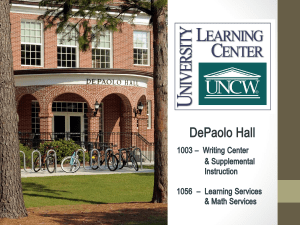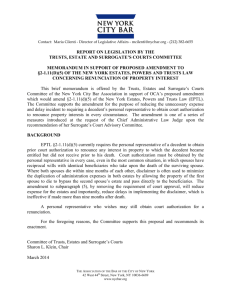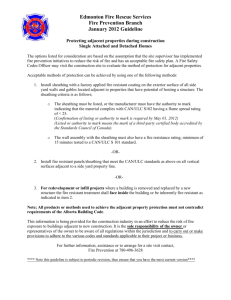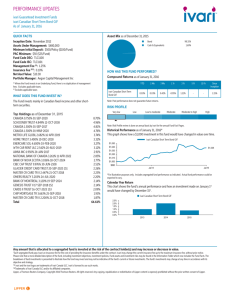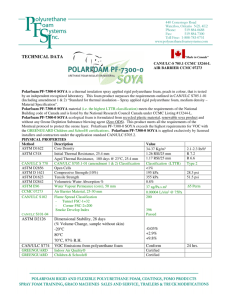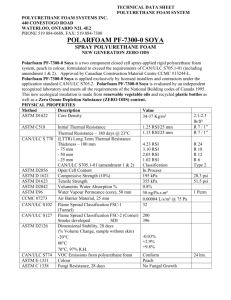TRUSTS AND ESTATES: TEACHING UNIFORM LAW THOMAS P
advertisement
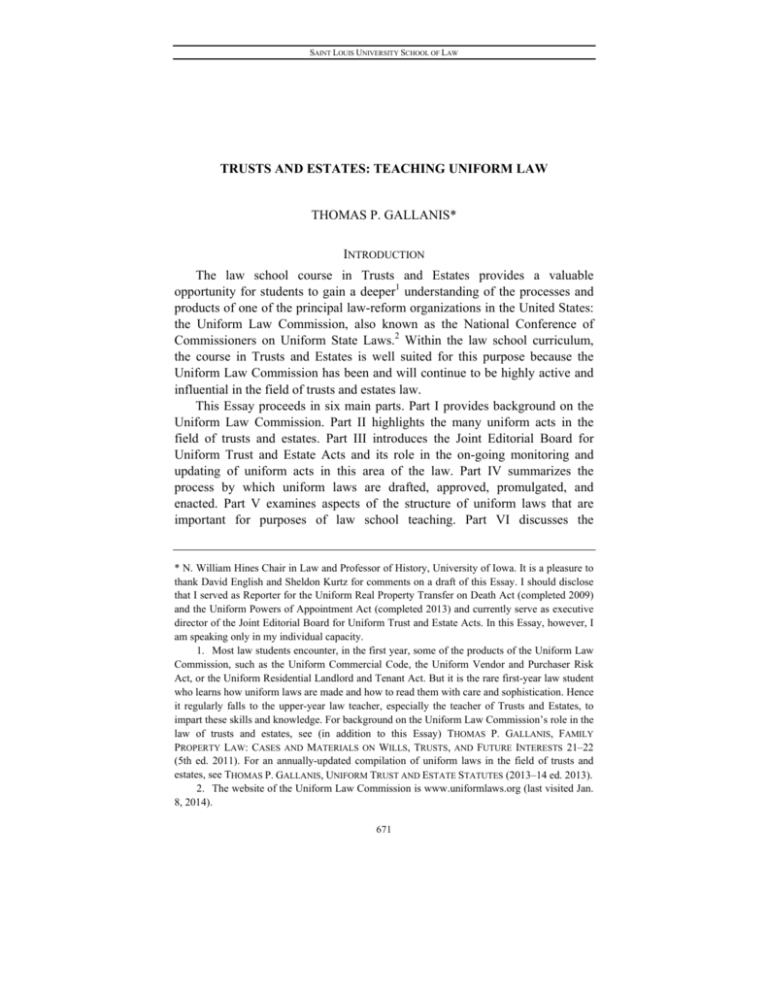
SAINT LOUIS UNIVERSITY SCHOOL OF LAW TRUSTS AND ESTATES: TEACHING UNIFORM LAW THOMAS P. GALLANIS* INTRODUCTION The law school course in Trusts and Estates provides a valuable opportunity for students to gain a deeper1 understanding of the processes and products of one of the principal law-reform organizations in the United States: the Uniform Law Commission, also known as the National Conference of Commissioners on Uniform State Laws.2 Within the law school curriculum, the course in Trusts and Estates is well suited for this purpose because the Uniform Law Commission has been and will continue to be highly active and influential in the field of trusts and estates law. This Essay proceeds in six main parts. Part I provides background on the Uniform Law Commission. Part II highlights the many uniform acts in the field of trusts and estates. Part III introduces the Joint Editorial Board for Uniform Trust and Estate Acts and its role in the on-going monitoring and updating of uniform acts in this area of the law. Part IV summarizes the process by which uniform laws are drafted, approved, promulgated, and enacted. Part V examines aspects of the structure of uniform laws that are important for purposes of law school teaching. Part VI discusses the * N. William Hines Chair in Law and Professor of History, University of Iowa. It is a pleasure to thank David English and Sheldon Kurtz for comments on a draft of this Essay. I should disclose that I served as Reporter for the Uniform Real Property Transfer on Death Act (completed 2009) and the Uniform Powers of Appointment Act (completed 2013) and currently serve as executive director of the Joint Editorial Board for Uniform Trust and Estate Acts. In this Essay, however, I am speaking only in my individual capacity. 1. Most law students encounter, in the first year, some of the products of the Uniform Law Commission, such as the Uniform Commercial Code, the Uniform Vendor and Purchaser Risk Act, or the Uniform Residential Landlord and Tenant Act. But it is the rare first-year law student who learns how uniform laws are made and how to read them with care and sophistication. Hence it regularly falls to the upper-year law teacher, especially the teacher of Trusts and Estates, to impart these skills and knowledge. For background on the Uniform Law Commission’s role in the law of trusts and estates, see (in addition to this Essay) THOMAS P. GALLANIS, FAMILY PROPERTY LAW: CASES AND MATERIALS ON WILLS, TRUSTS, AND FUTURE INTERESTS 21–22 (5th ed. 2011). For an annually-updated compilation of uniform laws in the field of trusts and estates, see THOMAS P. GALLANIS, UNIFORM TRUST AND ESTATE STATUTES (2013–14 ed. 2013). 2. The website of the Uniform Law Commission is www.uniformlaws.org (last visited Jan. 8, 2014). 671 SAINT LOUIS UNIVERSITY SCHOOL OF LAW 672 SAINT LOUIS UNIVERSITY LAW JOURNAL [Vol. 58:671 procedures for updating and amending uniform laws. A brief conclusion follows. I. THE UNIFORM LAW COMMISSION Organized in 1892, the Uniform Law Commission (ULC) is a state organization3 designed to foster uniformity of law through the voluntary cooperation of state governments.4 The ULC is funded largely5 by state appropriations, with ULC expenses apportioned among the states primarily on the basis of population.6 There are four categories of members of the ULC: commissioners,7 associate members,8 life members,9 and advisory members.10 Most members of the ULC are commissioners. Each commissioner represents a particular state and typically serves by gubernatorial appointment.11 Such appointments are for a fixed term (often three or four years), renewable at the governor’s discretion.12 The number of commissioners from each state is determined by the state itself; for example, Michigan currently has six commissioners (excluding life members) while Nevada has twelve.13 The 3. “State” includes the District of Columbia, Puerto Rico, and the U.S. Virgin Islands. About the ULC, UNIFORM LAW COMMISSION, http://www.uniformlaws.org/Narrative.aspx?title= About%20the%20ULC (last visited Jan. 8, 2014). 4. Id. 5. The ULC also receives contributions from other organizations, such as the American Law Institute. Frequently Asked Questions, UNIFORM LAW COMMISSION, http://www.uniform laws.org/Narrative.aspx?title=Frequently%20Asked%20Questions (last visited Jan. 8, 2014). In 1990, the ULC established the Uniform Law Foundation, a 501(c)(3) charitable organization, to support the ULC’s research and educational activities. About the ULF, UNIFORM LAW FOUNDATION, http://www.uniformlawfoundation.org (last visited Jan. 8, 2014). 6. UNIFORM LAW COMMISSION 2012–13 REFERENCE BOOK 9 (2013) [hereinafter “ULC REFERENCE BOOK”]. 7. Id. at 117. 8. The head of a state legislative bureau, or equivalent or delegate, is entitled to join the ULC as an associate member. An associate member may not serve as an officer of the ULC or participate in ULC votes. See id. 9. A commissioner who serves for a designated time (e.g., twenty years) is eligible to be elected by the ULC as a life member. Life members may participate in most of the ULC’s activities but not in a vote by the states unless authorized to do so under the law of the relevant state. In addition, a life member is not eligible to be elected ULC President. Id. at 117–18. 10. Id. at 119. 11. In some instances, a commissioner serves by virtue of state office. See, e.g., KANS. STAT. ANN. § 46-407(a) (1983) (providing that two of the Kansas commissioners “shall be the chairpersons of the house and senate standing committees on judiciary, except that each such chairperson may appoint another member of the committee on judiciary of the same house who is an attorney to serve as a member in lieu of such chairperson for such member’s then current term as a legislator.”). 12. ULC REFERENCE BOOK, supra note 6, at 117. 13. Id. at 44–47. SAINT LOUIS UNIVERSITY SCHOOL OF LAW 2014] TRUSTS AND ESTATES 673 length of a commissioner’s term is also determined by the state.14 The ULC imposes no restrictions on whom a governor may appoint, except one: a commissioner must be a member of a state bar.15 Commissioners serve as volunteers. The commissioners meet as a body on an annual basis, usually in the summer, to review and approve proposed uniform laws. Commissioners also serve throughout the year on drafting committees to prepare new uniform laws or on study committees to consider the feasibility of proposed drafting projects. Commissioners receive no compensation, and some states do not reimburse their commissioners’ meeting expenses.16 For more discussion of the uniform law-making process, see Part IV below. II. UNIFORM TRUST AND ESTATE ACTS The ULC is active in all fields of state law but particularly so in the field of trusts and estates. The principal uniform acts in this field are the Uniform Probate Code (UPC), originally promulgated in 1969 and substantially amended in 1990 and again in 2008,17 and the Uniform Trust Code (UTC), originally promulgated in 2000 and amended subsequently.18 These codes have been influential nationwide. The UPC, or an amended version of it, has been adopted in eighteen states.19 The UTC has been adopted in twenty-six states.20 The influence of the UPC and UTC on the law of trusts and estates is suggested by these numbers but in fact is even greater, because additional states have adopted the codes in part though not in whole.21 The ULC’s activity in the field of trusts and estates also extends beyond the UPC and UTC. The ULC website identifies over twenty-five current 14. Id. at 118. 15. Id. 16. Id. at 9. 17. Acts: Probate Code, UNIFORM LAW COMMISSION, http://www.uniformlaws.org/Act.as px?title=Probate%20Code (last visited Jan. 8, 2014). 18. Acts: Trust Code, UNIFORM LAW COMMISSION, http://uniformlaws.org/Act.aspx?title= Trust%20Code (last visited Jan. 8, 2014). 19. See Legislative Fact Sheet—Probate Code, UNIFORM LAW COMMISSION, www.uniform laws.org/LegislativeFactSheet.aspx?title=Probate Code (last visited Jan. 8, 2014). 20. See Legislative Fact Sheet—Trust Code, UNIFORM LAW COMMISSION, http://www.uni formlaws.org/LegislativeFactSheet.aspx?title=Trust Code (last visited Jan. 8, 2014). 21. See Barry A. Nelson, Summary of States that Adopted the Uniform Trust Code and those States’ Treatment of Exception Creditors, AMERICAN COLLEGE OF TRUST AND ESTATE COUNSEL, http://www.actec.org/public/Documents/Studies/Nelson_UTC_State_Laws_03_21_ 2013.pdf (last visited Jan. 8, 2014); Uniform Probate Code Locator, CORNELL.EDU, http://www.law.cornell.edu/uniform/probate.html (last visited Jan. 8, 2014). SAINT LOUIS UNIVERSITY SCHOOL OF LAW 674 SAINT LOUIS UNIVERSITY LAW JOURNAL [Vol. 58:671 uniform acts22 in the field.23 Below is a chart listing each of these acts in chronological order, along with the act’s reporter (principal drafter). The acts range from the UPC in 1969 to the Uniform Powers of Appointment Act in 2013. UNIFORM ACT (YEAR ORIGINALLY PROMULGATED) REPORTER Probate Code (1969) Richard Wellman (Chief Reporter) Disposition of Community Property Rights at Death Act (1971) Alan Polasky International Wills Act (1977), incorporated into UPC Article II Richard Wellman Transfers to Minors Act (1983) No reporter listed Drafting committee chaired by Lawrence Bugge Fraudulent Transfer Act (1984) Frank Kennedy Statutory Rule Against Perpetuities Act (1986), incorporated into UPC Article II Lawrence Waggoner Custodial Trust Act (1987) Eugene Scoles Nonprobate Transfers on Death Act (1989), incorporated into UPC Article VI John Langbein, Nathaniel Sterling, and Richard Wellman 22. Acts, UNIFORM LAW COMMISSION, http://www.uniformlaws.org/Acts.aspx (last visited Jan. 8, 2014). The chart in this Essay omits two superseded acts still listed on the ULC website: the Uniform Management of Institutional Funds Act (1972), superseded by the Uniform Prudent Management of Institutional Funds Act (2006), and the Uniform Durable Power of Attorney Act (1979), superseded by the Uniform Power of Attorney Act (2006). The chart also omits two model acts: the Model Marital Property Act (promulgated as a uniform act in 1983 but downgraded in 1996 to a model act) and the Model Oversight of Charitable Assets Act (2011). The distinction between a uniform act and a model act is explained in the ULC’s July 13, 2010, Statement of Policy Establishing Criteria and Procedures for Designation and Consideration of Acts. An act is designated a uniform act if “(A) there is a substantial reason to anticipate enactment in a large number of states; and (B) uniformity of the provisions of the proposed enactment among the states is a principal objective.” ULC REFERENCE BOOK, supra note 6, at 138–39. In contrast, an act is designated a model act if “(A) uniformity is a desirable objective, although not a principal objective; (B) the act may promote uniformity and minimize diversity, even though a significant number of states do not enact the act in its entirety; or (C) the purposes of the act can be substantially achieved even though it is not adopted in its entirety by every state.” Id. at 139. 23. See infra chart. SAINT LOUIS UNIVERSITY SCHOOL OF LAW 2014] TRUSTS AND ESTATES 675 TOD Security Registration Act (1989), incorporated into UPC Article VI Richard Wellman Testamentary Additions to Trusts Act (1991), incorporated into UPC Article II Lawrence Waggoner Health-Care Decisions Act (1993) Willard Pedrick (1991–92), David English (1992–93) Simultaneous Death Act (1993), incorporated into UPC Article II Lawrence Waggoner Prudent Investor Act (1994) John Langbein Guardianship and Protective Proceedings Act (1997), incorporated into UPC Article 5A Rebecca Morgan Principal and Income Act (1997) Joel Dobris and E. James Gamble Trust Code (2000) David English Disclaimer of Property Interests Act (2002), incorporated into UPC Article II William LaPiana Estate Tax Apportionment (2003), incorporated into UPC Article III Douglas Kahn Anatomical Gift Act (2006) Sheldon Kurtz Power of Attorney Act (2006), incorporated into UPC Article 5B Linda Whitton Prudent Management of Institutional Funds Act (2006) Susan Gary Adult Guardianship and Protective Proceedings Jurisdiction Act (2007) David English Principal and Income Act Amendments (2008) No reporter listed Drafting committee chaired by Suzanne Brown Walsh Probate Code Amendments (2008) Lawrence Waggoner Real Property Transfer on Death Act (2009), incorporated into UPC Article VI Thomas Gallanis Statutory Trust Entity Act (2009) Robert Sitkoff Insurable Interest Amendment to Uniform Trust Code (2010) Robert Jerry Premarital and Marital Agreements Act Brian Bix SAINT LOUIS UNIVERSITY SCHOOL OF LAW 676 SAINT LOUIS UNIVERSITY LAW JOURNAL [Vol. 58:671 (2012) Powers of Appointment Act (2013) Thomas Gallanis In addition to the acts already completed, the ULC is in the process of drafting uniform acts in the field of trusts and estates on the topics of Trust Decanting, Fiduciary Access to Digital Assets, and Interjurisdictional Recognition of Substitute Decision-Making Documents.24 III. THE JOINT EDITORIAL BOARD FOR UNIFORM TRUST AND ESTATE ACTS Uniform laws in the field of trusts and estates are not static. The laws are continually monitored and periodically amended. Much of this on-going work is done by a committee called the Joint Editorial Board for Uniform Trust and Estate Acts (JEB).25 The JEB is “joint” because it is composed of representatives from three organizations: the ULC, the American College of Trust and Estate Counsel,26 and the American Bar Association’s Section on Real Property, Trust and Estate Law.27 The JEB also has liaison members linking the JEB with the American Law Institute, the Association of American Law Schools, and state courts.28 All members of the JEB are lawyers or law professors with national reputations in the field of trusts and estates. The JEB meets annually, sometimes twice per year, depending on the items on its agenda. The JEB’s role in the uniform law-making process is discussed further in Parts IV and VI below. 24. See Fiduciary Access to Digital Assets, UNIFORM LAW COMMISSION, http://www.uni formlaws.org/Committee.aspx?title=Fiduciary%20Access%20to%20Digital%20Assets (last visited Jan. 8, 2014); Interjurisdictional Recognition of Substitute Decision Making Documents, UNIFORM LAW COMMISSION, http://uniformlaws.org/Committee.aspx?title=Interjurisdictional% 20Recognition%20of%20Substitute%20Decision%20Making%20Documents (last visited Jan. 8, 2014); Trust Decanting, UNIFORM LAW COMMISSION, http://www.uniformlaws.org/Committee.as px?title=Trust%20Decanting (last visited Jan. 8, 2014). 25. For JEB’s website, and a list of current members, see Joint Editorial Board for Uniform Trust and Estate Acts, UNIFORM LAW COMMISSION, http://www.uni formlaws.org/Committee. aspx?title=Joint%20Editorial%20Board%20for%20Uniform%20Trust%20and%20Estate% 20Acts (last visited Jan. 8, 2014). 26. For information about the College, see About ACTEC, ACTEC, www.actec.org/public/ AboutACTEC.asp (last visited Jan. 8, 2014). 27. For information about the Section, see Section of Real Property, Trusts and Estate Law, ABA www.americanbar.org/groups/real_property_trust_estate.html (last visited Jan. 8, 2014). 28. See ULC Drafting and Study Committee Projects, ABA 17, http://www.americanbar.org/ content/dam/aba/events/real_property_trust_estate/nclcf/2013_06/nclcf_viii_ulc_projects_list_ april_2013.authcheckdam.pdf (last visited Jan. 8, 2014). SAINT LOUIS UNIVERSITY SCHOOL OF LAW 2014] TRUSTS AND ESTATES 677 IV. THE UNIFORM LAW-MAKING PROCESS The ULC regularly invites the submission of proposals for new drafting projects.29 In the field of trusts and estates, the proposal often originates with the JEB. If not, the ULC seeks the JEB’s advice and recommendation. In either case, the proposal and the JEB’s views are considered by the ULC’s Committee on Scope and Program.30 If the Committee on Scope and Program recommends the appointment of a drafting committee or the appointment of a study committee (to study whether a drafting committee would be desirable), the recommendation goes to the ULC’s Executive Committee for its decision.31 The Executive Committee is likely to approve the appointment of a drafting committee if the proposed uniform act “(A) comports with the criteria of the ULC; (B) has the potential, in comparison with other pending proposals, of substantially contributing to the objectives of the ULC; and (C) will have adequate agenda time for its consideration.”32 If the Executive Committee approves the appointment of a drafting committee, the ULC’s leadership (including its President and Executive Director) identify a commissioner to chair the committee and commissioners to serve on it.33 Some commissioners on the committee are likely to have expertise on the topic, but not necessarily all of them. The leadership also identifies someone to serve as the committee’s reporter (principal drafter).34 The reporter need not be a commissioner and is often a law professor with a national reputation in the field. The drafting committee will also have an advisor appointed by the American Bar Association (ABA).35 If the act is in the field of trusts and estates, the advisor is typically appointed by the ABA’s Section on Real Property, Trust and Estate Law. The drafting process takes at least two years. Under the ULC Constitution, an act may be approved only after it has been considered (and, typically, read aloud) at a minimum of two annual meetings.36 The discussion at the “first reading” provides feedback to the drafting committee. The “final reading” ensures that the act is a polished product of which the ULC can be proud. 29. See New Project Proposals, UNIFORM LAW COMMISSION, www.uniformlaws.org/Narra tive.aspx?title=New Project Proposals (last visited Jan. 8, 2014). 30. See ULC Drafting Process, UNIFORM LAW COMMISSION, http://www.uniformlaws.org/ Narrative.aspx?title=ULC%20Drafting%20Process (last visited Jan. 8, 2014). 31. Id. 32. ULC REFERENCE BOOK, supra note 6, at 139 (Statement of Policy Establishing Criteria and Procedures for Designation and Consideration of Acts). 33. See ULC Drafting Process, supra note 30. 34. See Types of Committees, UNIFORM LAW COMMISSION, http://uniformlaws.org/Narra tive.aspx?title=Types%20of%20Committees (last visited Jan. 8, 2014). 35. Id. 36. See id. SAINT LOUIS UNIVERSITY SCHOOL OF LAW 678 SAINT LOUIS UNIVERSITY LAW JOURNAL [Vol. 58:671 During the drafting process, the drafting committee meets typically twice a year in person, or by conference call as appropriate. If the draft is in the field of trusts and estates, the draft is also vetted at meetings of the JEB, the American College of Trust and Estate Counsel, and the ABA’s Section on Real Property, Trust and Estate Law. In addition, the drafting committee seeks feedback from other individuals and organizations with an interest in the project. Uniform acts are drafted using a language, style, and structure approved by the ULC. During the drafting process, drafts of the act are reviewed by the ULC’s Committee on Style to ensure that the act comports with the ULC’s drafting rules.37 When the draft act is ready for approval by the ULC, it undergoes a final reading at a ULC annual meeting and then, at the same meeting, is put to a vote of the state delegations, with each delegation having one vote.38 An act is approved if it receives “an affirmative vote of 20 or more States, which vote must also constitute a majority of the States present and voting on the question.”39 After a uniform act is approved by a vote of the state delegations, the act is formally promulgated for consideration by state legislatures.40 Commissioners have an important role as advocates for the enactment of uniform laws in their states. The ULC encourages states “to adopt Uniform Acts exactly as written,”41 and this occasionally happens. More typically, however, the state legislature will make at least some modifications, often to conform the act to local law or practice.42 The ULC tracks the enactments and maintains a chart and database identifying where each uniform act has been enacted and whether the enacted version of it is essentially verbatim, substantially similar, or significantly amended.43 Teachers and students of trusts and estates need to remember that uniform acts are not state law until enacted by a state legislature 37. See Drafting Rules for Uniform and Model Acts, UNIFORM LAW COMMISSION (July 2012), www.uniformlaws.org/Shared/Publications/DraftingRules_2012.pdf (last visited Jan. 8, 2014). 38. ULC Drafting Process, supra note 30. 39. ULC REFERENCE BOOK, supra note 6, at 123. 40. ULC Drafting Process, supra note 30. 41. Id. 42. See, e.g., Sheldon F. Kurtz et al., The 2006 Revised Uniform Anatomical Gift Act—A Law to Save Lives, HEALTH L. ANALYSIS, Feb. 2007, at 44, 45. 43. See ULC REFERENCE BOOK, supra note 6, at 142–49. The ULC’s website also has enactment information about each act. See, e.g., Anatomical Gift Act (2006), UNIFORM LAW COMMISSION, http://www.uniformlaws.org/Act.aspx?title=Anatomical%20Gift%20Act% 20(2006) (last visited Jan. 8, 2014). SAINT LOUIS UNIVERSITY SCHOOL OF LAW 2014] TRUSTS AND ESTATES 679 and that the enacted version may vary—in minor or major respects—from the uniform text. V. THE STRUCTURE OF UNIFORM LAWS Uniform acts use a defined structure and format as specified in the ULC’s drafting rules. There are two aspects of this structure which,44 for purposes of law school teaching, merit discussion here. The first is that each uniform act contains definitions. These explain the defined terms deployed in the act. Definitions pertaining to the entire act are grouped together, in alphabetical order, near the beginning of the act. Definitions pertaining only to one part of an act—to one section, for example, or to one article in an act with multiple articles—are grouped together, in alphabetical order, at the beginning of that part. In order to understand a uniform act, one must refer to the definitions. Too often, students remain confused about the meaning of a provision in a uniform act because they have failed to consult the definitions. The second aspect of structure to mention for pedagogical purposes is that a uniform act contains both the black-letter and the comments. The black-letter is the statute. The comments, written by the act’s reporter and approved by the chair of the drafting committee, explain the statute—sometimes in considerable detail and with illustrative examples. Almost every section of black-letter has an accompanying comment. In order to understand a uniform act, one must read not only the black-letter but also the accompanying comment. VI. UPDATING UNIFORM LAWS Uniform laws in trusts and estates are not static. They are monitored by the JEB and can be updated. Sometimes a uniform act is so archaic that a new act on the topic is needed, in which case a drafting committee is appointed to prepare the new act. If a deficiency in a uniform act can be remedied by an amendment, the procedures for doing so depend on the nature of the amendment. The easiest kind of amendment to make is a ministerial amendment. Examples of a ministerial amendment are a minor change to a comment or a purely stylistic change to the black-letter—for example, replacing the gendered word “his” with the gender-neutral words “the decedent’s.” A ministerial amendment may be approved by the ULC’s Executive Director. 44. See e.g., Drafting Rules for Uniform and Model Acts, supra note 37, at R. 301, R. 302 cmt. SAINT LOUIS UNIVERSITY SCHOOL OF LAW 680 SAINT LOUIS UNIVERSITY LAW JOURNAL [Vol. 58:671 Somewhat more time-consuming is the process for making a technical amendment. As defined by the ULC Constitution, a technical amendment is an amendment designed “to remove an ambiguity, to conform the Act to federal law as required to accomplish the purposes of the Act, to correct a technical error, to meet an unanticipated objection, to conform the Act to a trend of judicial decisions, or to achieve a similar objective.”45 A technical amendment may be approved by the ULC’s Executive Committee, which must then report the amendment to the members of the ULC within thirty days (or at an annual meeting, if earlier).46 If no commissioner files an objection to the amendment within thirty days after the report, the amendment is deemed to be approved by the ULC.47 If a commissioner files an objection within the thirty days, the amendment “remains in abeyance unless it is approved or modified by the [ULC] at the next annual meeting on a special order not later than the third day of that meeting.”48 The most time-consuming amendment is neither ministerial nor technical. Such an amendment requires the appointment of a drafting committee—which might, but need not, be the JEB—and approval at a ULC annual meeting under the standard procedures for approving uniform acts. The periodic revision of uniform laws has both cautionary and beneficial effects in the classroom. The cautionary effect is that students and teachers need to be sure to consult up-to-date versions of the laws—both the blackletter and the comments. The beneficial effect is that classroom discussion can lead to improvement of the law. Students and teachers of the course in Trusts and Estates should see themselves as participants in the uniform law-making process. Ideas for improvements in uniform laws, or for new uniform laws, are welcome. CONCLUSION We are now more than four decades after the promulgation of the Uniform Probate Code and more than one decade after the promulgation of the Uniform Trust Code. These uniform laws, and many others in the field, have profoundly shaped the law of trusts and estates. Indeed, it is fair to say that the story of trusts and estates law in our lifetimes has been the story of law reform49—and the reform continues. 45. ULC REFERENCE BOOK, supra note 6, at 120. 46. Id. If the technical amendment is only to a comment, not to the black-letter, the amendment needs only the approval of the ULC Executive Committee. 47. Id. 48. Id. 49. For a personal account by one of the leading reformers of the field, see Lawrence W. Waggoner, Why I Do Law Reform, 45 U. MICH. J.L. REFORM 727 (2012). SAINT LOUIS UNIVERSITY SCHOOL OF LAW 2014] TRUSTS AND ESTATES 681

